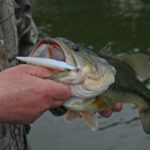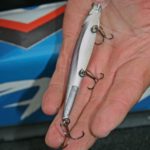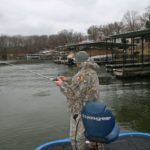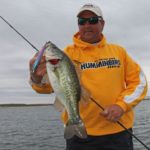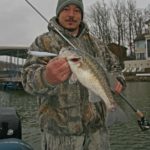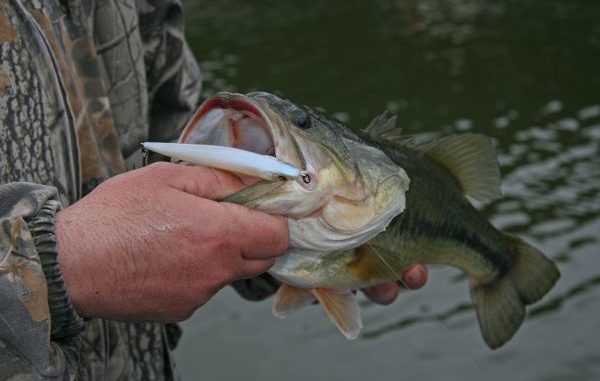
Bass become lethargic in cold water, but that doesn’t mean they won’t bite. Tie on a jerkbait and hang it in front of a fish’s face for plenty of wintertime action.
Cold water, shallow water, clear water; plenty of situations make it hard to get fish to bite. For largemouth bass, one of the biggest mistakes anglers make in these conditions is fishing too fast and pulling baits through the strike zone with only a brief window of opportunity for predators to make their move.
However, holding a bait in place in the water column, or at least moving it with a slow and vulnerable cadence, will net you more attention from hungry fish that are just not in the mood to chase.
Dropshots are one answer, but for covering water and making those slow presentations over a broad area, your best bet is a suspending bait. Lipped jerkbaits or lipless twitchers do the trick in a variety of depths by appealing to a bass’ seasonal disposition.
FLW Tour pro Jim Dillard of West Monroe is one who capitalizes on this tactic.
“This is one of my favorite ways to fish during (the colder months),” Dillard said. “What it reminds the bass of is a dying shad. In the winter, when the water gets cold, you generally have quite a few dying shad.
“It comes down to the basic principle of shad — mimicking their food source. Bass are still predators and they have to eat to survive. So when they see (the jerkbait), you’re not necessarily getting a reaction bite by moving something by them really fast, but they’re still reacting to something that reminds them, ‘Hey, I gotta eat something.’ And it’s right there sitting in front of them.”
A stretch of sunny weather can spark the jerkbait bite, as the solar warmth reaches into the chilly water and encourages prespawners to move up and feed. The fish become more cautious with higher visibility, but a windy day can balance things out by breaking up the surface and lowering that caution level.
Productive scenarios
Dillard said a jerkbait is typically a more common choice in clear, deeper waters like those of Caney Lake and Lake Bruin.
However, one of the key attributes of a successful angler is the absence of hard-and-fast rules. In the case of jerkbaits, don’t hesitate to throw them when you can touch the bottom with your rod tip.
While the bait’s name might inherently imply the tactic of jerking it down into the water column and taunting fish holding deeper, Dillard said jerkbaits can also play a role in many of Louisiana’s shallow fisheries.
The principle doesn’t change, wherever you use this type of lure: It’s all about keeping a prospective meal vulnerable.
“We fish a lot of cypress trees where I’m from, and I use a suspending jerkbait quite a bit,” Dillard said. “A suspending Smithwick Rogue is one of my favorite ones. You have to let it sit, and it’s a boring way to fish.
“But if the fish are there, they just can’t stand seeing something sit in front of them.”
The key is how the bait can be positioned in front of a fish.
“They’re already sluggish because of the cold water, and that jerkbait is the perfect bait to sit there, whereas you can put a light weight on a soft plastic and give it a slow fall but it’s going to go down to the bottom,” he said. “A suspending jerkbait is pretty much the only thing that’s just going to sit right there in front of them.
“You might just barely twitch it, and they’ll eat it.”
For Dillard, the notion of fishing a jerkbait near the trees that thrive in the water is just as sensible as throwing the bait near docks along southern bayous. Minding seasonal patterns makes this an easy decision, he said.
“We all grew up knowing how to fish cypress trees because, in the winter and the spring, the bigger fish live on the cypress trees,” Dillard explained. “Later in the year, they get off the cypress trees and get on dead wood — logs, laydowns and stuff like that. In the winter months, they’re getting ready in their prespawn areas around the cypress trees because they know they’re going to be spawning on the trees.
“That’s an easy target during the winter months — you just throw that suspending bait right up beside that tree, jerk it down two or three little old jerks and just let it sit there. Maybe count to four or five and just barely tick it.”
Moving deeper
Complementing Dillard’s shallow tactics for jerkbait presentations, you’ll definitely want to have a deeper-reaching model tied on when working areas with greater depth.
For this work, Dillard likes an old-school Spoonbill Rogue or the heavier Lucky Craft StayCee 90 and Pointer 100. The latter two, he said, allow for longer casts — especially helpful in windy conditions.
Other popular jerkbaits include the Rapala XRap and Husky Jerk, Megabass Vision 110, Bomber Long A and Jackall Squad Minnow.
In the depths of winter, lethargy pulls a lot of the spunk out of a bass, and the fish may just slap at a jerkbait with minimal enthusiasm, poor aim or a blend of both. This is when you’ll appreciate the extra grabbing power of baits with three sets of trebles like the Strike King KVD Wild Shiner, the Cotton Cordell Redfin or the Lucky Craft Flash Pointer.
“The fish are really lethargic, and they just swim around the bait — they don’t really try and eat it,” said Dillard’s fellow touring pro Brent Ehrler. “It’s almost like they’re slashing through it, just trying to kill it.
“That extra treble just increases your odds of catching them.”
Ehrler makes his home in Redlands, Calif., but he finds the jerkbait an essential tool for winter bass wherever he travels.
Essential to this strategy, he said, is packing a variety of jerkbait sizes and styles so you can fish where the fish are holding and present the appropriate bait profile.
Favoring the Flash Pointer for that 3- to 5-foot zone, he also keeps a couple of different divers handy. Deep fish will occasionally rise to investigate a shallow suspending jerkbait, but they often arrive complacent.
“A lot of times, they travel a long way for that shallower bait, and by the time they get there it’s almost like they just lost interest,” Ehler said. “Get the bait down to them and they don’t have to travel as far, and they usually end up biting it.”
On the other hand, Bassmaster Elite Series pro Mike McClelland knows the value of long, patient pauses with suspending jerkbaits like the Spro McStick he helped design.
He uses a pulling or a sweeping motion — rather than a twitch — and then he lets it idle for several seconds to achieve maximum audience time. Experience has taught him that there could be a gang of potential takers holding twice as deep as his bait reaches, and a vulnerable meal might just entice them to tiptoe upstairs.
“That’s why you want to let the bait sit longer — to give those deep fish time to commit to coming up in the water column,” McClelland said.
As far as colors go, remember that imitating shad is the top priority. That being said, natural baitfish colors like Strike King’s heralded sexy shad are tough to beat.
However, Dillard said that on the occasions in which he’s used a jerkbait in stained water — a less common, yet potentially productive scenario — he has fared well with a more eye-catching silver/black back/orange belly Rogue.
“Jerkbaits seem to work best when the water is clear to stained — as long as it’s not muddy,” Dillard said.
